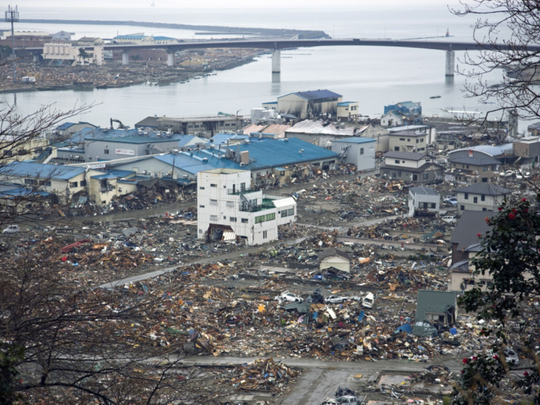
LOS ANGELES
Scientists studying Japan’s 2011 Tohoku earthquake say they’ve found a faster method than seismic waves to tell when a quake is on its way.
The findings, described in the journal Nature Communications, track the subtle gravitational shifts that can occur immediately after the initial rupture, and could help researchers design faster and more powerful warning technologies.
“This new paper is the first [observational evidence] that this phenomenon really happens,” said study co-author Jean Paul Ampuero, a Caltech seismologist. “This is important because of the doors it opens for early warning.”
When an earthquake begins, people typically have only a few moments to prepare before the ground starts to shake. Seismic waves known as P-waves — waves of compression and dilation that travel through the earth from the rupture — can, if detected, allow people a few crucial seconds or even minutes of preparation, depending on their distance from the epicentre. But while P-waves travel fast (perhaps from 1 to 14 kilometres per second), their travel time still eats up some of that precious warning window.
Fast response
Scientists have long thought that they might be able to get an even quicker heads-up by looking at changes in the gravitational signal at the rupture event — changes caused as massive chunks of earth move, making various spots more or less dense and thus altering their gravitational tug. Because gravity propagates at the speed of light, this signal theoretically could provide a near-instantaneous way to detect an earthquake as soon as it starts, even at great distances from the epicentre.
The problem is that it’s very, very difficult to detect that gravitational signal amid all the noise — including, for example, the rising and falling of the tides caused by the moon’s massive tug. In order to pick up such a signal, scientists would need to have a very powerful gravimeter close to an event with comparatively little noise that would drown the signal out.
The 2011 Tohoku earthquake provided just such an event. The 9.0 magnitude quake, which triggered a tsunami that led to a meltdown at the Fukushima-Daiichi nuclear power plant and resulted in the deaths of more than 15,000 people, happened offshore and about 510 kilometers from the Kamioka Observatory’s superconducting gravimeter, a very powerful instrument.
The scientists measured the signal hitting the Kamioka gravimeter at about 65 seconds after the rupture event — about nine seconds before the seismic waves even arrived. Sure enough, after removing all the noise, they did find a gravitational shift emanating from the event some 510 kilometres away, proving that such detections were possible.
For this paper, the scientists chose to look 65 seconds after rupture in order to get a strong reading, because the gravity signal started out weak but grew in strength. But ideally, future instruments could be sensitive enough to detect ruptures perhaps five seconds after they occur — which could, depending on a person’s distance from the epicentre, provide precious moments extra to prepare. “In Japan, for example, they could gain more than 20 seconds for any earthquake warning happening offshore,” Ampuero said.
The few seconds afforded to those close to a rupture might not seem like much but, if linked to automated systems, could still mitigate the damage.
“For people, a minute is a very long time; you can start taking protective actions,” Ampuero said. But closer to the epicentre, with just five or 10 seconds to spare, automated programmes that would stop a train, an elevator or heavy machinery could still kick in, he said.
Of course, that will require a whole new generation of powerful, sensitive technologies that have yet to be developed, he added. Building them will likely take several years.
“We’re working with other teams who have developed sensors for other applications but have pieces of the technology that will be useful for this,” he said. “And if we had the funding to do it right now ... in three years we would have a proof of concept of many of the key technologies, and perhaps in five years...a pilot sensor.”
Susan Hough of the US Geological Survey in Pasadena, California, who was not involved in the study, expressed some skepticism that the findings would result in a practical tool.
She wrote in an email: “The fundamental physics problem is that, while the waves travel at the speed of light, gravity waves are generated by fault movement, and in a big earthquake the fault movement takes a while.”
“For effective early warning you can’t wait for an earthquake to get big,” she added. “The trick is to figure out quickly after it starts that it’s going to get big.”
—Los Angeles Times













